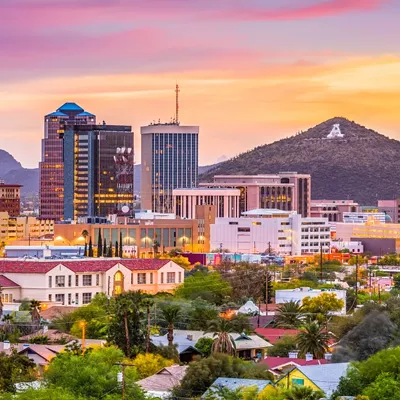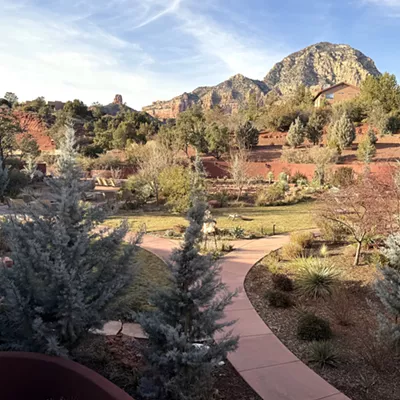Flowers never bloomed. Cactuses withered and died. Trees failed to green up as they normally do.
The dire warnings of possible regulations restricting water consumption have already been heard, and the traditional start of any kind of rainy season is still weeks away.
As Arizona moves from a very arid spring into another summer of drought conditions, we've admittedly got trouble right here in River City. Actually, we've got lots of troubles on lots of fronts--because there's no river in many of Arizona's rivers, and you'd be hard-pressed to find an optimist who will predict better days on the immediate horizon.
Hopefully, desert dwellers didn't get too complacent when the cooling and healing rains fell in 2005 to interrupt a decade-long pattern of drought, because it appears that enjoyable interruption was only temporary--and Tucson's 2005 precipitation totals still came in 2 1/2 inches below normal.
"It takes several years to get into a drought, and it usually takes lots more years to get out of one," says Arizona State University climatologist Andrew Ellis. From nearby Nevada, fellow climatologist Kelly Redmond, of the Desert Research Institute in Reno, adds, "This is pretty unusual territory we're in--not unprecedented, but not normal, either. You've got to go back to the early 1900s to find a comparable timeframe when water storage levels got down as low as they have been in recent years."
It's bad for humans--but even worse for animals.
"Food, water, shelter and space, arranged in the correct order, are requirements of all living things," says Tom Whetten, spokesman for the Tucson regional branch of the Arizona Game and Fish Department. "Part of the current problem is that the necessities of life are not suitably arranged. Animals have a rough time when they can find something to eat in one location, but then have to travel 10 miles to locate something to drink. For example, the traditional diet for a bear involves only 10 percent from the meat group and the rest from grasses, nuts, berries and insects. If only limited rain has fallen, acorn trees will keep the limited rainfall for its own use and will not produce a nut crop. If there's no nut crop, what will the bears eat, and where will they find it? In many cases, there's not enough habitat to ensure critter survival."
Outdoor expert Jonathan Hanson says it's natural that reports of rural animals prowling urban neighborhoods increase when food and drink in the wilderness becomes scarce. "The idea that humans and nature are separate and never the twain shall meet is a disturbing concept," says the author of There's a Bobcat in My Backyard! "The human/animal cycle has fueled life on Earth for the last 3 billion years. We need to interact with it and deal with specific problems as they arise."
Game and Fish Urban Wildlife Specialist Elissa Ostergaard says there are some common-sense suggestions that can minimize the potential for negative reactions.
"We need to modify human behavior a bit so that folks can coexist and live responsibly with area wildlife," she says, advocating a standard desert do's-and-don'ts list. "Drought makes urban areas seem like oases for wildlife, because animals can find reliable sources of food, water and shelter around homes, parks and golf courses. Resist putting out food or water for wildlife and remove attractants, like pet food, water bowls and garbage from around your home. And don't allow wild animals to get comfortable in your residential neighborhood. Discourage them by lighting up the area, spraying intruders with a hose or making lots of noise." (For more information, see the Living With Wildlife Web page at www.azgfd.gov/urbanwildlife.)
Because a lack of water can spell doom to thirsty animals, Game and Fish works to haul water to catchments all over the state in times of drought. "These permanent facilities are all over the place," says Whetten, citing a specific example of catchments that dam up little washes in the Catalina Mountains. "But we don't have any rain to capture or a way to haul water to some of the remote sites, so Tucson Electric Power has volunteered to help by using their four-wheel-drive water-hauler trucks. They're purchasing water from the city of Tucson, hauling it to the catchments and refilling the watering holes."
Current drought conditions are debilitating to critters in the woods, and even optimist-at-heart Duane Shroufe, director of the Game and Fish Department, acknowledges this. "There's nothing normal when it comes to the precipitation patterns Arizona experiences, so you can't count on anything. Drought one day, flooding the next. Control is left up to the 'Big Biologist' in the sky. But this isn't the first time we've lived with low water conditions. And it won't be the last."
Teacher/scientist/author Bill Broyles, in his book Our Sonoran Desert, describes the 120,000 square miles that Tucson calls its backyard "a vast ecological jewel." But it's a gem that needs to be washed occasionally in order to maintain its sparkle. Broyles becomes a poet when he writes: "Kissed by the dew of a winter's morning or whipped by rain from a thunderstorm, that's the desert's most distinctive fragrance. It is clean and pure. It symbolizes persistence and endurance and it means water and flowers, renewal and tomorrow."
May that long-awaited restoration happen soon.









